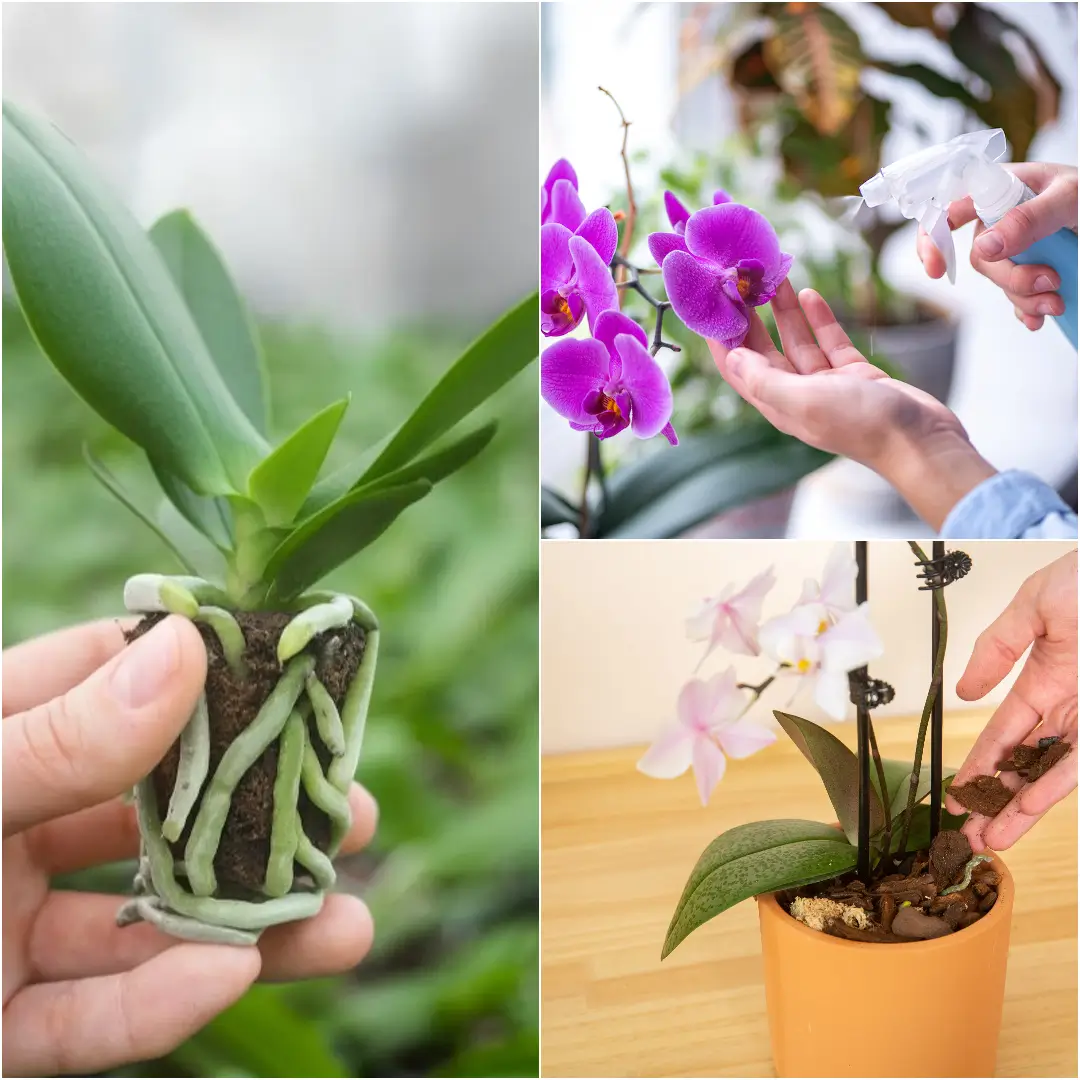Orchids are like the crown jewels of the plant world. With their elegant, delicate blooms, they add a touch of sophistication to any space. But, as beautiful as they are, orchids can sometimes feel like a mystery when it comes to their care. Not to worry though, because once you get the hang of it, orchids are actually pretty straightforward to care for! Whether you’re a seasoned gardener or just starting out, I’m going to walk you through everything you need to know about how to care for orchids.
The Basics of Orchid Care
Light: The Key to Blooms
If orchids could talk, they’d probably tell you they love the sunshine but not too much of it! Orchids thrive in bright, indirect light. The best spot for them is near a south- or east-facing window where they can soak in the sun without getting scorched. Think of them like a sunbather under a beach umbrella—they want the light, but without the risk of sunburn.
But what happens if they get too much direct sunlight? Those beautiful leaves can start to look a little sad, with burns or brown spots appearing. If you notice this happening, it’s a clear sign to move them out of the direct rays. On the other hand, if they’re not getting enough light, you might notice their leaves turning a darker green than usual—a signal they’re not happy and could use more light.
Choosing the Right Soil
Orchids aren’t like your everyday houseplant. Throwing them into regular potting soil is like giving a marathon runner heavy boots—it just won’t work! Orchids need something much lighter and more breathable.
So, what kind of growing medium do they like? A mix of bark, sphagnum moss, perlite, and peat is the perfect recipe. This combination allows water to drain quickly while keeping the roots aerated. Orchids in soggy soil are just asking for trouble—root rot, to be specific—so always avoid traditional potting soil. Think of their roots like lungs; they need to breathe!
Watering Orchids: Don’t Drown Them!
Watering orchids is an art, but it’s one you can master easily. These plants aren’t needy when it comes to water, but they do require a bit of attention. You’ll want to let the growing medium dry out between waterings. That’s right—orchids don’t like sitting in soggy soil. When the pot feels light and the soil feels dry to the touch, it’s time to give your orchid a drink.
Here’s a trick: check the roots. If they’re plump and white or green, they’re happy and well-hydrated. If they’re looking gray and shriveled, it’s time for a little TLC. And if the roots are black or mushy, that’s a sign they’ve been overwatered and might be starting to rot.
Orchids typically need watering twice a week during the warmer months, when they’re actively growing, and once a week (or less) in winter. Use room-temperature water and water slowly until it flows out of the drainage holes in the pot.
Humidity and Temperature: Creating the Perfect Environment
Orchids are like that friend who loves tropical vacations—they thrive in warm, humid environments. Ideally, your orchids will do best with temperatures between 50 and 90 degrees Fahrenheit and humidity levels of 40% to 70%. If you live in a dry climate, don’t fret! You can increase humidity by placing your orchid’s pot on a tray of water with pebbles or misting the plant regularly.
However, watch out for cold drafts and dry air from heating vents. Orchids are sensitive to sudden temperature changes, so keeping them in a stable environment is essential.
Feeding and Fertilizing Orchids
Orchids, like all plants, need a little nourishment now and then. During the growing season (spring and summer), feed your orchid with an orchid-specific fertilizer or a balanced one like 20-20-20. Be sure to dilute it—a little goes a long way. And don’t forget to cut back on fertilizing during the winter months, when your orchid is likely in a dormant phase.
The secret to a thriving orchid? Patience. Just like us, they have their active and restful periods, and the dormant stage is all about conserving energy for their next spectacular bloom.
Pruning Orchids for Longevity
Pruning orchids isn’t just about keeping them looking neat; it’s about encouraging new growth. After your orchid finishes blooming, you’ll notice the flower spike (the stem where the flowers were) starting to brown. Cut off the old flower spike to redirect the plant’s energy into growing fresh blooms.
For some orchids, like the Phalaenopsis (moth orchid), if the flower spike is still green, it might re-bloom from the same spike! However, once it turns brown, it’s time to prune.
Repotting Your Orchid: When and How to Do It
Orchids may look like they enjoy their pots, but over time, they outgrow them. The general rule is to repot your orchid every 1-2 years or when you notice the roots spilling out of the pot. Never repot when the orchid is in bloom; wait until it’s finished flowering.
When it’s time to repot, gently remove the orchid from its old pot, trim any dead or damaged roots, and set it in a new pot with fresh orchid-growing medium. Don’t pack the medium too tightly, as the roots need air circulation to stay healthy. Clear plastic pots with drainage holes are a good option because they allow you to monitor the roots.
Getting Orchids to Re-Bloom
Here’s the million-dollar question: How do you get an orchid to re-bloom? It’s all about creating the right conditions. Orchids should bloom at least once a year, but some species, like Phalaenopsis, might need a little nudge. One trick is to drop the temperature by 10 degrees for a few nights to trigger blooming. But more importantly, make sure your orchid is getting the proper light, water, temperature, and care.
Dealing with Orchid Pests and Diseases
Orchids aren’t just beautiful—they can be a magnet for pests, too. Common enemies include aphids, spider mites, mealybugs, and whiteflies. If you see any of these critters, don’t panic. A gentle spray of insecticidal soap or neem oil will usually do the trick. Sometimes, a simple jet of water can wash them away.
Orchids are also prone to root rot if overwatered, as well as fungal infections like anthracnose or petal blight. Prevention is key, so always keep an eye on your watering habits.
Common Problems with Orchids and How to Fix Them
Even with the best care, orchids can sometimes run into problems. Here are a few common issues and how to tackle them:
Wrinkled or Shriveled Leaves
This is usually a sign of underwatering. Check the roots—if they’re plump, the plant might be dehydrated. Adjust your watering schedule to ensure your orchid is getting enough moisture.
Yellow Leaves
Yellowing leaves often indicate overwatering or root rot. Let the growing medium dry out completely before watering again. If the problem persists, it might be time to repot and trim any dead roots.
Drooping Leaves
This could be caused by underwatering or a lack of light. Move your orchid to a spot with brighter, indirect light and adjust your watering routine.
Bud Drop
If your orchid’s buds fall off before they bloom, it’s a sign of stress. This could be due to temperature fluctuations, drafts, low humidity, or improper watering. Try relocating the plant to a more stable environment.
Enjoy Your Orchid’s Beauty!
Orchids are one of nature’s most stunning creations, and while they may seem high-maintenance at first, once you understand their needs, they’re surprisingly easy to care for. From choosing the right light and soil to watering them properly and tackling pests, orchids reward your attention with breathtaking blooms. So, go ahead and pamper your orchid—it’s worth the effort!
With the right care, your orchids will thrive, grow, and keep you smiling with their spectacular displays of color and elegance.
I hope this guide helps you keep your orchids happy and blooming! Let me know how your orchid care journey goes—remember, patience and care will bring out their best!
FAQs
How do you take care of an indoor orchid?
Caring for an indoor orchid involves providing bright, indirect light, watering it properly (allowing the medium to dry between waterings), maintaining humidity levels between 40-70%, and keeping the plant in a temperature range of 50-90°F. Fertilize during the growing season and prune spent flower spikes to encourage re-blooming.
How do you keep potted orchids alive?
To keep a potted orchid alive, use a well-draining orchid mix (like bark or moss), water it sparingly, and ensure the pot has drainage holes. Orchids also need regular humidity, indirect sunlight, and occasional fertilization. Repot every 1-2 years with fresh orchid-specific growing medium to prevent root rot and maintain healthy growth.
How often should you water an orchid?
Water your orchid about once a week, or when the growing medium has dried out. During the growing season (spring and summer), you might need to water twice a week, but in the winter, reduce watering to once every 10-14 days. Be sure to use room-temperature water and allow it to drain completely.
Do orchids need sunlight?
Yes, orchids need sunlight, but not direct sunlight. They prefer bright, indirect light, such as what you’d get from a south- or east-facing window. Direct sunlight can burn their leaves, so it’s best to filter or diffuse the light for your orchid’s comfort.


